Analysis of Business Organization and Law
VerifiedAdded on 2020/10/23
|14
|4640
|231
AI Summary
The assignment covers a wide range of topics related to business organization and law, including commentaries on the law of business organization, effect of sharing economy on tourism industry employment, and problems in contract law. It also includes studies on limited liability companies, the concept of limited liability, and transnational business problems.
Contribute Materials
Your contribution can guide someone’s learning journey. Share your
documents today.
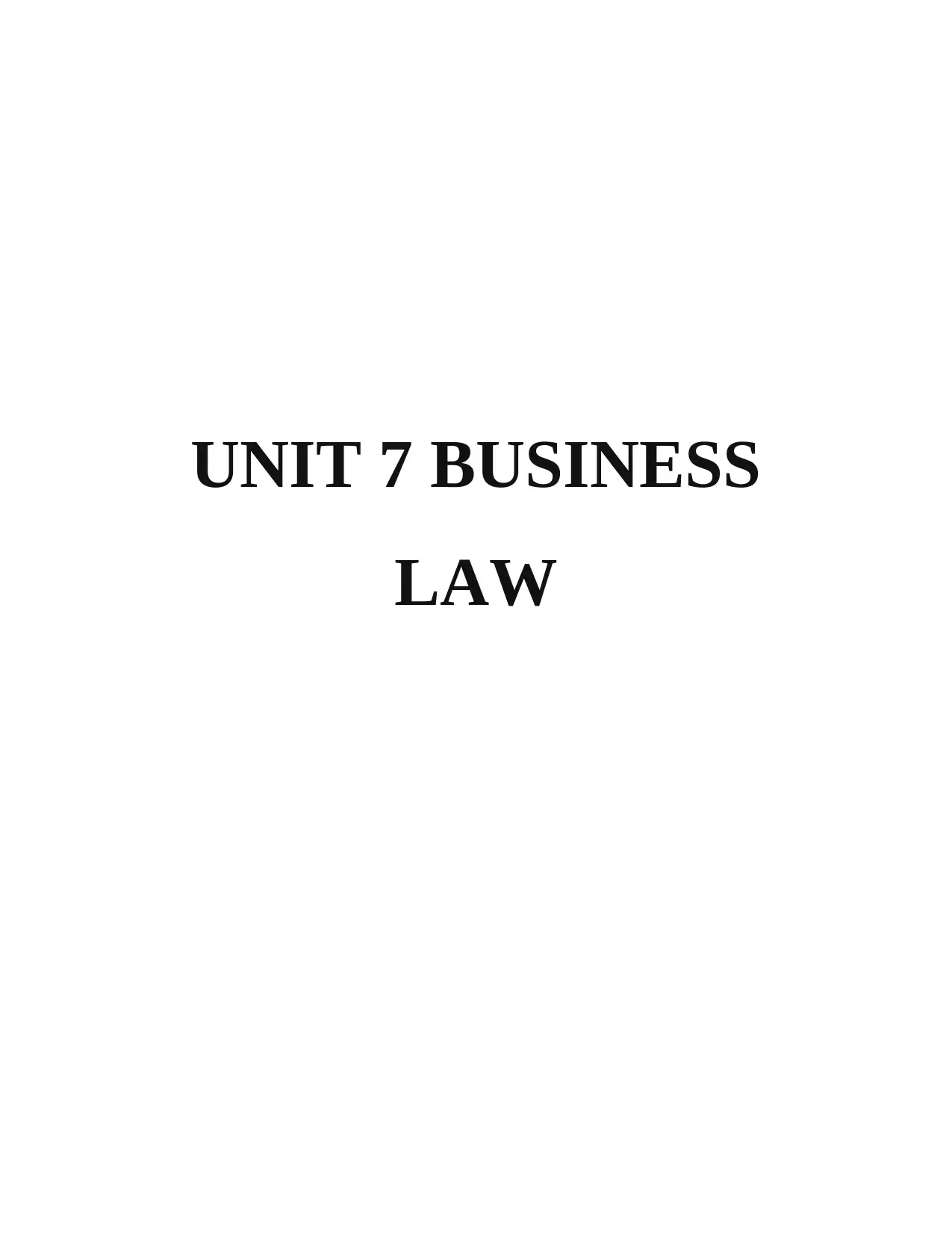
UNIT 7 BUSINESS
LAW
LAW
Secure Best Marks with AI Grader
Need help grading? Try our AI Grader for instant feedback on your assignments.
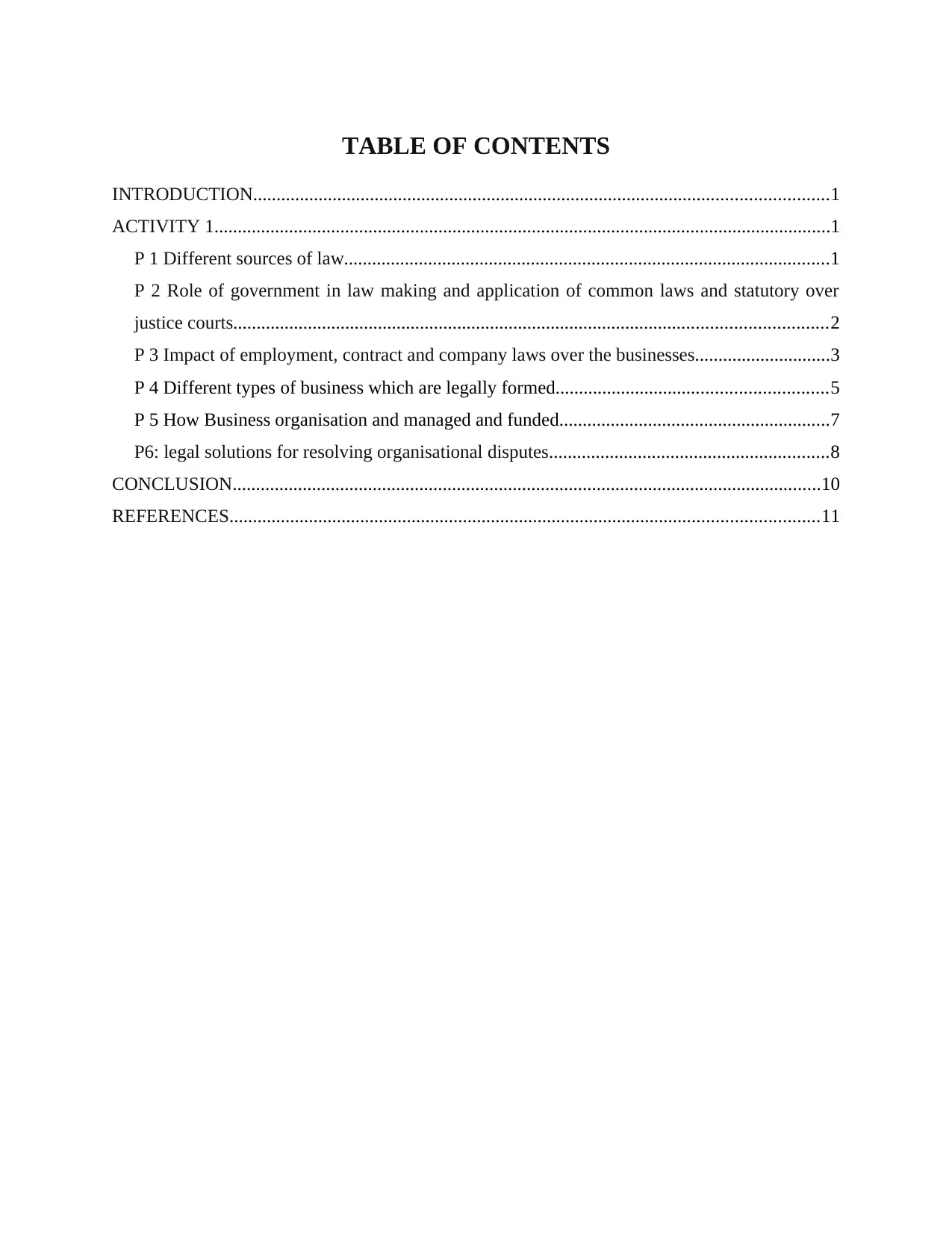
TABLE OF CONTENTS
INTRODUCTION...........................................................................................................................1
ACTIVITY 1....................................................................................................................................1
P 1 Different sources of law........................................................................................................1
P 2 Role of government in law making and application of common laws and statutory over
justice courts...............................................................................................................................2
P 3 Impact of employment, contract and company laws over the businesses.............................3
P 4 Different types of business which are legally formed..........................................................5
P 5 How Business organisation and managed and funded..........................................................7
P6: legal solutions for resolving organisational disputes............................................................8
CONCLUSION..............................................................................................................................10
REFERENCES..............................................................................................................................11
INTRODUCTION...........................................................................................................................1
ACTIVITY 1....................................................................................................................................1
P 1 Different sources of law........................................................................................................1
P 2 Role of government in law making and application of common laws and statutory over
justice courts...............................................................................................................................2
P 3 Impact of employment, contract and company laws over the businesses.............................3
P 4 Different types of business which are legally formed..........................................................5
P 5 How Business organisation and managed and funded..........................................................7
P6: legal solutions for resolving organisational disputes............................................................8
CONCLUSION..............................................................................................................................10
REFERENCES..............................................................................................................................11
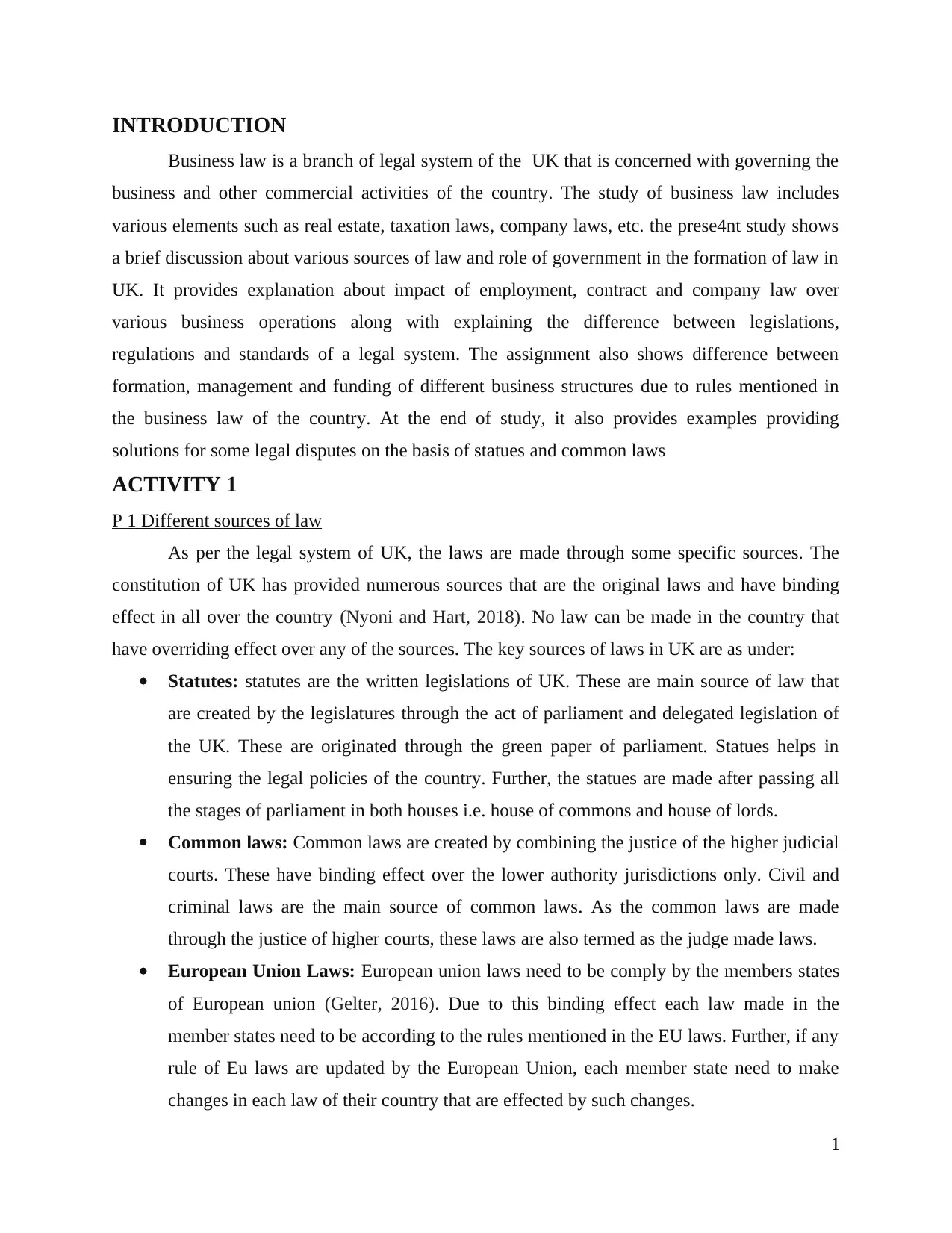
INTRODUCTION
Business law is a branch of legal system of the UK that is concerned with governing the
business and other commercial activities of the country. The study of business law includes
various elements such as real estate, taxation laws, company laws, etc. the prese4nt study shows
a brief discussion about various sources of law and role of government in the formation of law in
UK. It provides explanation about impact of employment, contract and company law over
various business operations along with explaining the difference between legislations,
regulations and standards of a legal system. The assignment also shows difference between
formation, management and funding of different business structures due to rules mentioned in
the business law of the country. At the end of study, it also provides examples providing
solutions for some legal disputes on the basis of statues and common laws
ACTIVITY 1
P 1 Different sources of law
As per the legal system of UK, the laws are made through some specific sources. The
constitution of UK has provided numerous sources that are the original laws and have binding
effect in all over the country (Nyoni and Hart, 2018). No law can be made in the country that
have overriding effect over any of the sources. The key sources of laws in UK are as under:
Statutes: statutes are the written legislations of UK. These are main source of law that
are created by the legislatures through the act of parliament and delegated legislation of
the UK. These are originated through the green paper of parliament. Statues helps in
ensuring the legal policies of the country. Further, the statues are made after passing all
the stages of parliament in both houses i.e. house of commons and house of lords.
Common laws: Common laws are created by combining the justice of the higher judicial
courts. These have binding effect over the lower authority jurisdictions only. Civil and
criminal laws are the main source of common laws. As the common laws are made
through the justice of higher courts, these laws are also termed as the judge made laws.
European Union Laws: European union laws need to be comply by the members states
of European union (Gelter, 2016). Due to this binding effect each law made in the
member states need to be according to the rules mentioned in the EU laws. Further, if any
rule of Eu laws are updated by the European Union, each member state need to make
changes in each law of their country that are effected by such changes.
1
Business law is a branch of legal system of the UK that is concerned with governing the
business and other commercial activities of the country. The study of business law includes
various elements such as real estate, taxation laws, company laws, etc. the prese4nt study shows
a brief discussion about various sources of law and role of government in the formation of law in
UK. It provides explanation about impact of employment, contract and company law over
various business operations along with explaining the difference between legislations,
regulations and standards of a legal system. The assignment also shows difference between
formation, management and funding of different business structures due to rules mentioned in
the business law of the country. At the end of study, it also provides examples providing
solutions for some legal disputes on the basis of statues and common laws
ACTIVITY 1
P 1 Different sources of law
As per the legal system of UK, the laws are made through some specific sources. The
constitution of UK has provided numerous sources that are the original laws and have binding
effect in all over the country (Nyoni and Hart, 2018). No law can be made in the country that
have overriding effect over any of the sources. The key sources of laws in UK are as under:
Statutes: statutes are the written legislations of UK. These are main source of law that
are created by the legislatures through the act of parliament and delegated legislation of
the UK. These are originated through the green paper of parliament. Statues helps in
ensuring the legal policies of the country. Further, the statues are made after passing all
the stages of parliament in both houses i.e. house of commons and house of lords.
Common laws: Common laws are created by combining the justice of the higher judicial
courts. These have binding effect over the lower authority jurisdictions only. Civil and
criminal laws are the main source of common laws. As the common laws are made
through the justice of higher courts, these laws are also termed as the judge made laws.
European Union Laws: European union laws need to be comply by the members states
of European union (Gelter, 2016). Due to this binding effect each law made in the
member states need to be according to the rules mentioned in the EU laws. Further, if any
rule of Eu laws are updated by the European Union, each member state need to make
changes in each law of their country that are effected by such changes.
1
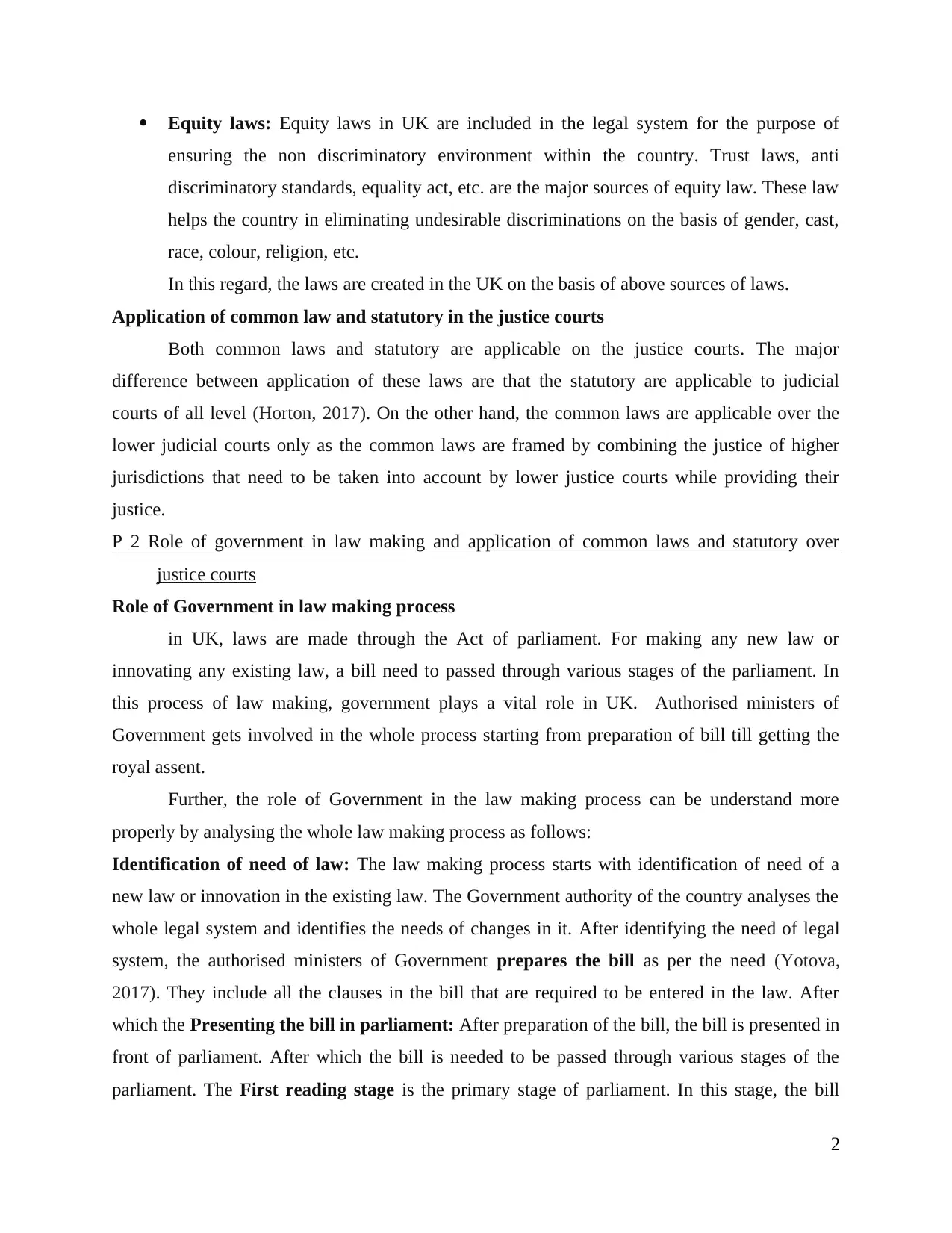
Equity laws: Equity laws in UK are included in the legal system for the purpose of
ensuring the non discriminatory environment within the country. Trust laws, anti
discriminatory standards, equality act, etc. are the major sources of equity law. These law
helps the country in eliminating undesirable discriminations on the basis of gender, cast,
race, colour, religion, etc.
In this regard, the laws are created in the UK on the basis of above sources of laws.
Application of common law and statutory in the justice courts
Both common laws and statutory are applicable on the justice courts. The major
difference between application of these laws are that the statutory are applicable to judicial
courts of all level (Horton, 2017). On the other hand, the common laws are applicable over the
lower judicial courts only as the common laws are framed by combining the justice of higher
jurisdictions that need to be taken into account by lower justice courts while providing their
justice.
P 2 Role of government in law making and application of common laws and statutory over
justice courts
Role of Government in law making process
in UK, laws are made through the Act of parliament. For making any new law or
innovating any existing law, a bill need to passed through various stages of the parliament. In
this process of law making, government plays a vital role in UK. Authorised ministers of
Government gets involved in the whole process starting from preparation of bill till getting the
royal assent.
Further, the role of Government in the law making process can be understand more
properly by analysing the whole law making process as follows:
Identification of need of law: The law making process starts with identification of need of a
new law or innovation in the existing law. The Government authority of the country analyses the
whole legal system and identifies the needs of changes in it. After identifying the need of legal
system, the authorised ministers of Government prepares the bill as per the need (Yotova,
2017). They include all the clauses in the bill that are required to be entered in the law. After
which the Presenting the bill in parliament: After preparation of the bill, the bill is presented in
front of parliament. After which the bill is needed to be passed through various stages of the
parliament. The First reading stage is the primary stage of parliament. In this stage, the bill
2
ensuring the non discriminatory environment within the country. Trust laws, anti
discriminatory standards, equality act, etc. are the major sources of equity law. These law
helps the country in eliminating undesirable discriminations on the basis of gender, cast,
race, colour, religion, etc.
In this regard, the laws are created in the UK on the basis of above sources of laws.
Application of common law and statutory in the justice courts
Both common laws and statutory are applicable on the justice courts. The major
difference between application of these laws are that the statutory are applicable to judicial
courts of all level (Horton, 2017). On the other hand, the common laws are applicable over the
lower judicial courts only as the common laws are framed by combining the justice of higher
jurisdictions that need to be taken into account by lower justice courts while providing their
justice.
P 2 Role of government in law making and application of common laws and statutory over
justice courts
Role of Government in law making process
in UK, laws are made through the Act of parliament. For making any new law or
innovating any existing law, a bill need to passed through various stages of the parliament. In
this process of law making, government plays a vital role in UK. Authorised ministers of
Government gets involved in the whole process starting from preparation of bill till getting the
royal assent.
Further, the role of Government in the law making process can be understand more
properly by analysing the whole law making process as follows:
Identification of need of law: The law making process starts with identification of need of a
new law or innovation in the existing law. The Government authority of the country analyses the
whole legal system and identifies the needs of changes in it. After identifying the need of legal
system, the authorised ministers of Government prepares the bill as per the need (Yotova,
2017). They include all the clauses in the bill that are required to be entered in the law. After
which the Presenting the bill in parliament: After preparation of the bill, the bill is presented in
front of parliament. After which the bill is needed to be passed through various stages of the
parliament. The First reading stage is the primary stage of parliament. In this stage, the bill
2
Secure Best Marks with AI Grader
Need help grading? Try our AI Grader for instant feedback on your assignments.
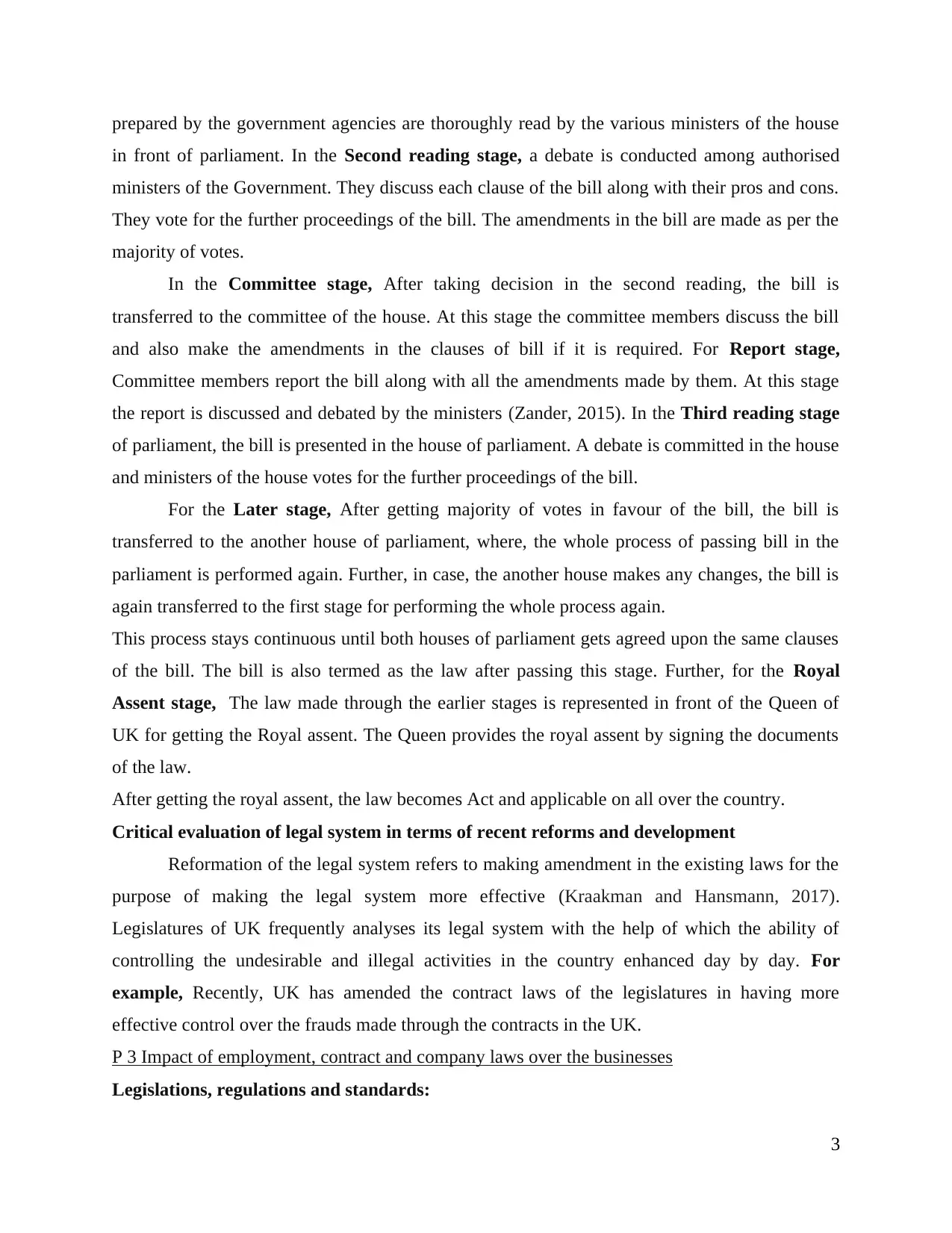
prepared by the government agencies are thoroughly read by the various ministers of the house
in front of parliament. In the Second reading stage, a debate is conducted among authorised
ministers of the Government. They discuss each clause of the bill along with their pros and cons.
They vote for the further proceedings of the bill. The amendments in the bill are made as per the
majority of votes.
In the Committee stage, After taking decision in the second reading, the bill is
transferred to the committee of the house. At this stage the committee members discuss the bill
and also make the amendments in the clauses of bill if it is required. For Report stage,
Committee members report the bill along with all the amendments made by them. At this stage
the report is discussed and debated by the ministers (Zander, 2015). In the Third reading stage
of parliament, the bill is presented in the house of parliament. A debate is committed in the house
and ministers of the house votes for the further proceedings of the bill.
For the Later stage, After getting majority of votes in favour of the bill, the bill is
transferred to the another house of parliament, where, the whole process of passing bill in the
parliament is performed again. Further, in case, the another house makes any changes, the bill is
again transferred to the first stage for performing the whole process again.
This process stays continuous until both houses of parliament gets agreed upon the same clauses
of the bill. The bill is also termed as the law after passing this stage. Further, for the Royal
Assent stage, The law made through the earlier stages is represented in front of the Queen of
UK for getting the Royal assent. The Queen provides the royal assent by signing the documents
of the law.
After getting the royal assent, the law becomes Act and applicable on all over the country.
Critical evaluation of legal system in terms of recent reforms and development
Reformation of the legal system refers to making amendment in the existing laws for the
purpose of making the legal system more effective (Kraakman and Hansmann, 2017).
Legislatures of UK frequently analyses its legal system with the help of which the ability of
controlling the undesirable and illegal activities in the country enhanced day by day. For
example, Recently, UK has amended the contract laws of the legislatures in having more
effective control over the frauds made through the contracts in the UK.
P 3 Impact of employment, contract and company laws over the businesses
Legislations, regulations and standards:
3
in front of parliament. In the Second reading stage, a debate is conducted among authorised
ministers of the Government. They discuss each clause of the bill along with their pros and cons.
They vote for the further proceedings of the bill. The amendments in the bill are made as per the
majority of votes.
In the Committee stage, After taking decision in the second reading, the bill is
transferred to the committee of the house. At this stage the committee members discuss the bill
and also make the amendments in the clauses of bill if it is required. For Report stage,
Committee members report the bill along with all the amendments made by them. At this stage
the report is discussed and debated by the ministers (Zander, 2015). In the Third reading stage
of parliament, the bill is presented in the house of parliament. A debate is committed in the house
and ministers of the house votes for the further proceedings of the bill.
For the Later stage, After getting majority of votes in favour of the bill, the bill is
transferred to the another house of parliament, where, the whole process of passing bill in the
parliament is performed again. Further, in case, the another house makes any changes, the bill is
again transferred to the first stage for performing the whole process again.
This process stays continuous until both houses of parliament gets agreed upon the same clauses
of the bill. The bill is also termed as the law after passing this stage. Further, for the Royal
Assent stage, The law made through the earlier stages is represented in front of the Queen of
UK for getting the Royal assent. The Queen provides the royal assent by signing the documents
of the law.
After getting the royal assent, the law becomes Act and applicable on all over the country.
Critical evaluation of legal system in terms of recent reforms and development
Reformation of the legal system refers to making amendment in the existing laws for the
purpose of making the legal system more effective (Kraakman and Hansmann, 2017).
Legislatures of UK frequently analyses its legal system with the help of which the ability of
controlling the undesirable and illegal activities in the country enhanced day by day. For
example, Recently, UK has amended the contract laws of the legislatures in having more
effective control over the frauds made through the contracts in the UK.
P 3 Impact of employment, contract and company laws over the businesses
Legislations, regulations and standards:
3
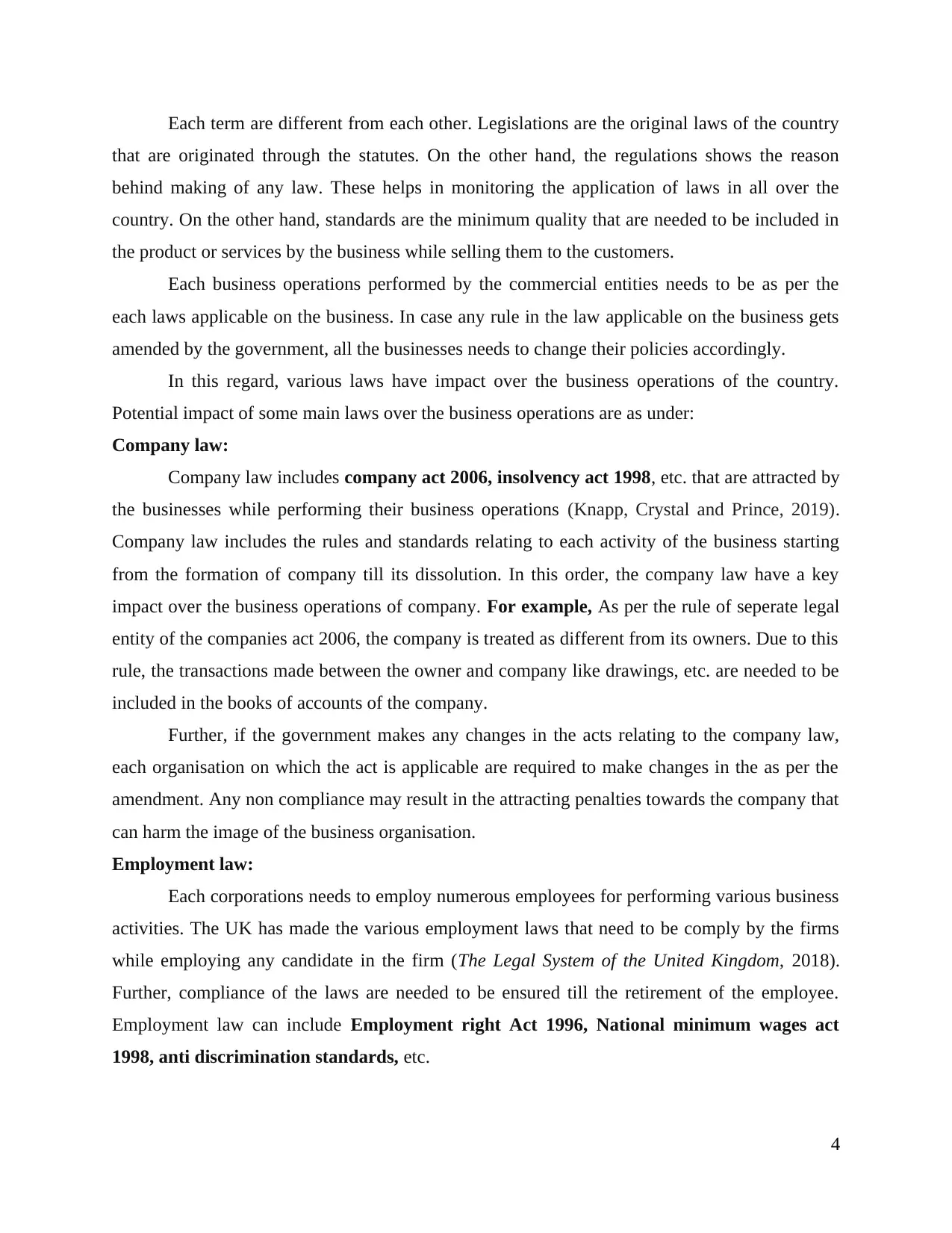
Each term are different from each other. Legislations are the original laws of the country
that are originated through the statutes. On the other hand, the regulations shows the reason
behind making of any law. These helps in monitoring the application of laws in all over the
country. On the other hand, standards are the minimum quality that are needed to be included in
the product or services by the business while selling them to the customers.
Each business operations performed by the commercial entities needs to be as per the
each laws applicable on the business. In case any rule in the law applicable on the business gets
amended by the government, all the businesses needs to change their policies accordingly.
In this regard, various laws have impact over the business operations of the country.
Potential impact of some main laws over the business operations are as under:
Company law:
Company law includes company act 2006, insolvency act 1998, etc. that are attracted by
the businesses while performing their business operations (Knapp, Crystal and Prince, 2019).
Company law includes the rules and standards relating to each activity of the business starting
from the formation of company till its dissolution. In this order, the company law have a key
impact over the business operations of company. For example, As per the rule of seperate legal
entity of the companies act 2006, the company is treated as different from its owners. Due to this
rule, the transactions made between the owner and company like drawings, etc. are needed to be
included in the books of accounts of the company.
Further, if the government makes any changes in the acts relating to the company law,
each organisation on which the act is applicable are required to make changes in the as per the
amendment. Any non compliance may result in the attracting penalties towards the company that
can harm the image of the business organisation.
Employment law:
Each corporations needs to employ numerous employees for performing various business
activities. The UK has made the various employment laws that need to be comply by the firms
while employing any candidate in the firm (The Legal System of the United Kingdom, 2018).
Further, compliance of the laws are needed to be ensured till the retirement of the employee.
Employment law can include Employment right Act 1996, National minimum wages act
1998, anti discrimination standards, etc.
4
that are originated through the statutes. On the other hand, the regulations shows the reason
behind making of any law. These helps in monitoring the application of laws in all over the
country. On the other hand, standards are the minimum quality that are needed to be included in
the product or services by the business while selling them to the customers.
Each business operations performed by the commercial entities needs to be as per the
each laws applicable on the business. In case any rule in the law applicable on the business gets
amended by the government, all the businesses needs to change their policies accordingly.
In this regard, various laws have impact over the business operations of the country.
Potential impact of some main laws over the business operations are as under:
Company law:
Company law includes company act 2006, insolvency act 1998, etc. that are attracted by
the businesses while performing their business operations (Knapp, Crystal and Prince, 2019).
Company law includes the rules and standards relating to each activity of the business starting
from the formation of company till its dissolution. In this order, the company law have a key
impact over the business operations of company. For example, As per the rule of seperate legal
entity of the companies act 2006, the company is treated as different from its owners. Due to this
rule, the transactions made between the owner and company like drawings, etc. are needed to be
included in the books of accounts of the company.
Further, if the government makes any changes in the acts relating to the company law,
each organisation on which the act is applicable are required to make changes in the as per the
amendment. Any non compliance may result in the attracting penalties towards the company that
can harm the image of the business organisation.
Employment law:
Each corporations needs to employ numerous employees for performing various business
activities. The UK has made the various employment laws that need to be comply by the firms
while employing any candidate in the firm (The Legal System of the United Kingdom, 2018).
Further, compliance of the laws are needed to be ensured till the retirement of the employee.
Employment law can include Employment right Act 1996, National minimum wages act
1998, anti discrimination standards, etc.
4
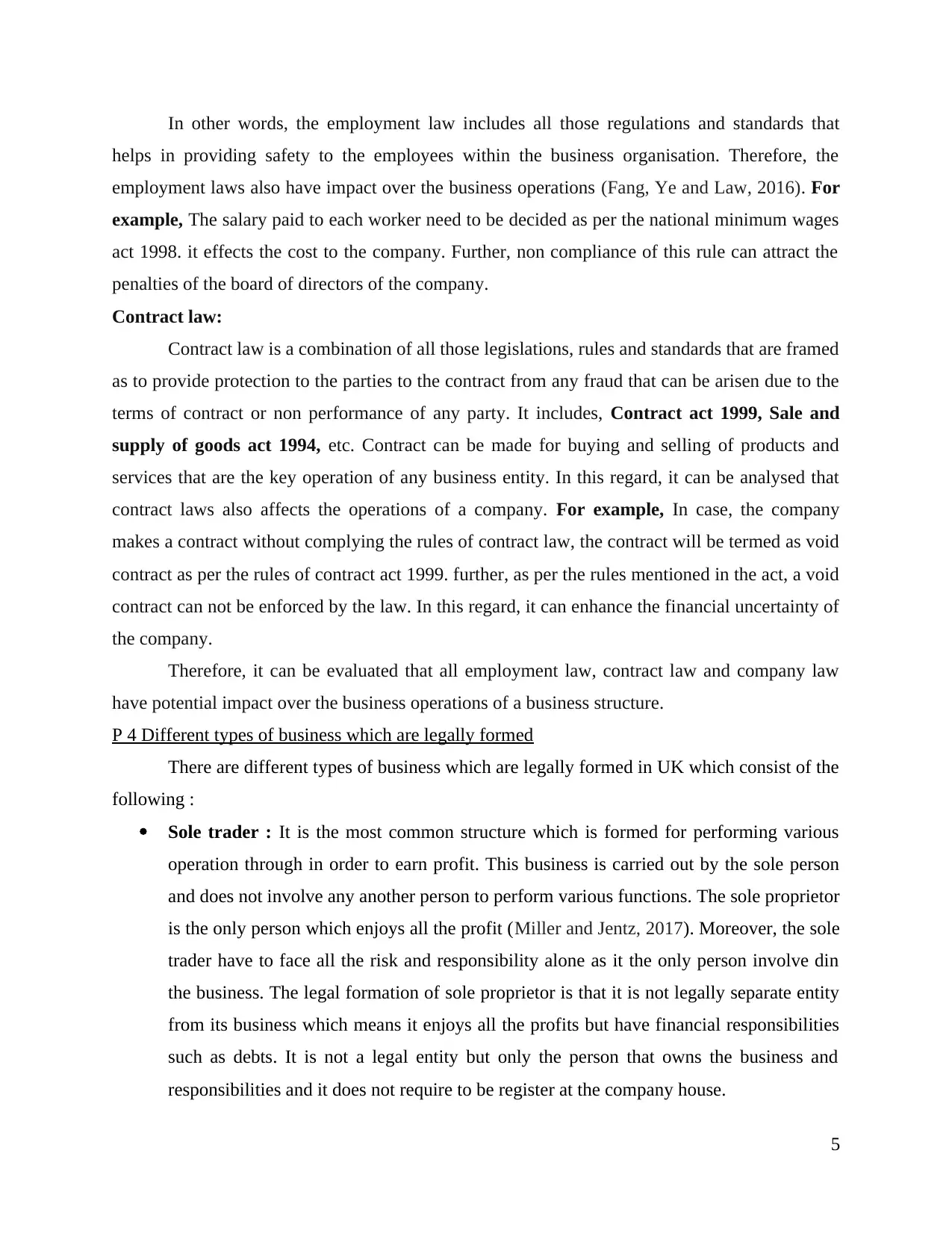
In other words, the employment law includes all those regulations and standards that
helps in providing safety to the employees within the business organisation. Therefore, the
employment laws also have impact over the business operations (Fang, Ye and Law, 2016). For
example, The salary paid to each worker need to be decided as per the national minimum wages
act 1998. it effects the cost to the company. Further, non compliance of this rule can attract the
penalties of the board of directors of the company.
Contract law:
Contract law is a combination of all those legislations, rules and standards that are framed
as to provide protection to the parties to the contract from any fraud that can be arisen due to the
terms of contract or non performance of any party. It includes, Contract act 1999, Sale and
supply of goods act 1994, etc. Contract can be made for buying and selling of products and
services that are the key operation of any business entity. In this regard, it can be analysed that
contract laws also affects the operations of a company. For example, In case, the company
makes a contract without complying the rules of contract law, the contract will be termed as void
contract as per the rules of contract act 1999. further, as per the rules mentioned in the act, a void
contract can not be enforced by the law. In this regard, it can enhance the financial uncertainty of
the company.
Therefore, it can be evaluated that all employment law, contract law and company law
have potential impact over the business operations of a business structure.
P 4 Different types of business which are legally formed
There are different types of business which are legally formed in UK which consist of the
following :
Sole trader : It is the most common structure which is formed for performing various
operation through in order to earn profit. This business is carried out by the sole person
and does not involve any another person to perform various functions. The sole proprietor
is the only person which enjoys all the profit (Miller and Jentz, 2017). Moreover, the sole
trader have to face all the risk and responsibility alone as it the only person involve din
the business. The legal formation of sole proprietor is that it is not legally separate entity
from its business which means it enjoys all the profits but have financial responsibilities
such as debts. It is not a legal entity but only the person that owns the business and
responsibilities and it does not require to be register at the company house.
5
helps in providing safety to the employees within the business organisation. Therefore, the
employment laws also have impact over the business operations (Fang, Ye and Law, 2016). For
example, The salary paid to each worker need to be decided as per the national minimum wages
act 1998. it effects the cost to the company. Further, non compliance of this rule can attract the
penalties of the board of directors of the company.
Contract law:
Contract law is a combination of all those legislations, rules and standards that are framed
as to provide protection to the parties to the contract from any fraud that can be arisen due to the
terms of contract or non performance of any party. It includes, Contract act 1999, Sale and
supply of goods act 1994, etc. Contract can be made for buying and selling of products and
services that are the key operation of any business entity. In this regard, it can be analysed that
contract laws also affects the operations of a company. For example, In case, the company
makes a contract without complying the rules of contract law, the contract will be termed as void
contract as per the rules of contract act 1999. further, as per the rules mentioned in the act, a void
contract can not be enforced by the law. In this regard, it can enhance the financial uncertainty of
the company.
Therefore, it can be evaluated that all employment law, contract law and company law
have potential impact over the business operations of a business structure.
P 4 Different types of business which are legally formed
There are different types of business which are legally formed in UK which consist of the
following :
Sole trader : It is the most common structure which is formed for performing various
operation through in order to earn profit. This business is carried out by the sole person
and does not involve any another person to perform various functions. The sole proprietor
is the only person which enjoys all the profit (Miller and Jentz, 2017). Moreover, the sole
trader have to face all the risk and responsibility alone as it the only person involve din
the business. The legal formation of sole proprietor is that it is not legally separate entity
from its business which means it enjoys all the profits but have financial responsibilities
such as debts. It is not a legal entity but only the person that owns the business and
responsibilities and it does not require to be register at the company house.
5
Paraphrase This Document
Need a fresh take? Get an instant paraphrase of this document with our AI Paraphraser
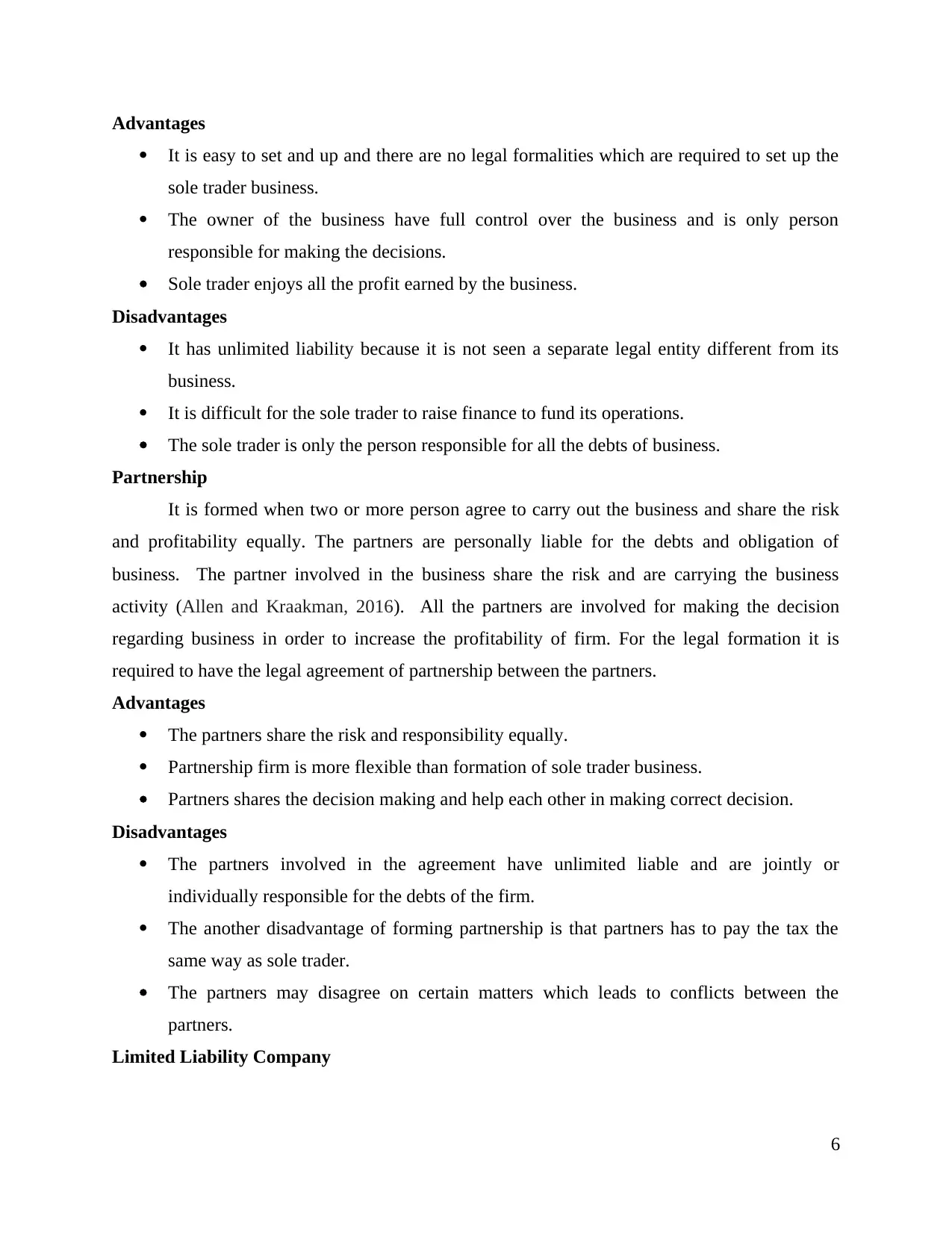
Advantages
It is easy to set and up and there are no legal formalities which are required to set up the
sole trader business.
The owner of the business have full control over the business and is only person
responsible for making the decisions.
Sole trader enjoys all the profit earned by the business.
Disadvantages
It has unlimited liability because it is not seen a separate legal entity different from its
business.
It is difficult for the sole trader to raise finance to fund its operations.
The sole trader is only the person responsible for all the debts of business.
Partnership
It is formed when two or more person agree to carry out the business and share the risk
and profitability equally. The partners are personally liable for the debts and obligation of
business. The partner involved in the business share the risk and are carrying the business
activity (Allen and Kraakman, 2016). All the partners are involved for making the decision
regarding business in order to increase the profitability of firm. For the legal formation it is
required to have the legal agreement of partnership between the partners.
Advantages
The partners share the risk and responsibility equally.
Partnership firm is more flexible than formation of sole trader business.
Partners shares the decision making and help each other in making correct decision.
Disadvantages
The partners involved in the agreement have unlimited liable and are jointly or
individually responsible for the debts of the firm.
The another disadvantage of forming partnership is that partners has to pay the tax the
same way as sole trader.
The partners may disagree on certain matters which leads to conflicts between the
partners.
Limited Liability Company
6
It is easy to set and up and there are no legal formalities which are required to set up the
sole trader business.
The owner of the business have full control over the business and is only person
responsible for making the decisions.
Sole trader enjoys all the profit earned by the business.
Disadvantages
It has unlimited liability because it is not seen a separate legal entity different from its
business.
It is difficult for the sole trader to raise finance to fund its operations.
The sole trader is only the person responsible for all the debts of business.
Partnership
It is formed when two or more person agree to carry out the business and share the risk
and profitability equally. The partners are personally liable for the debts and obligation of
business. The partner involved in the business share the risk and are carrying the business
activity (Allen and Kraakman, 2016). All the partners are involved for making the decision
regarding business in order to increase the profitability of firm. For the legal formation it is
required to have the legal agreement of partnership between the partners.
Advantages
The partners share the risk and responsibility equally.
Partnership firm is more flexible than formation of sole trader business.
Partners shares the decision making and help each other in making correct decision.
Disadvantages
The partners involved in the agreement have unlimited liable and are jointly or
individually responsible for the debts of the firm.
The another disadvantage of forming partnership is that partners has to pay the tax the
same way as sole trader.
The partners may disagree on certain matters which leads to conflicts between the
partners.
Limited Liability Company
6
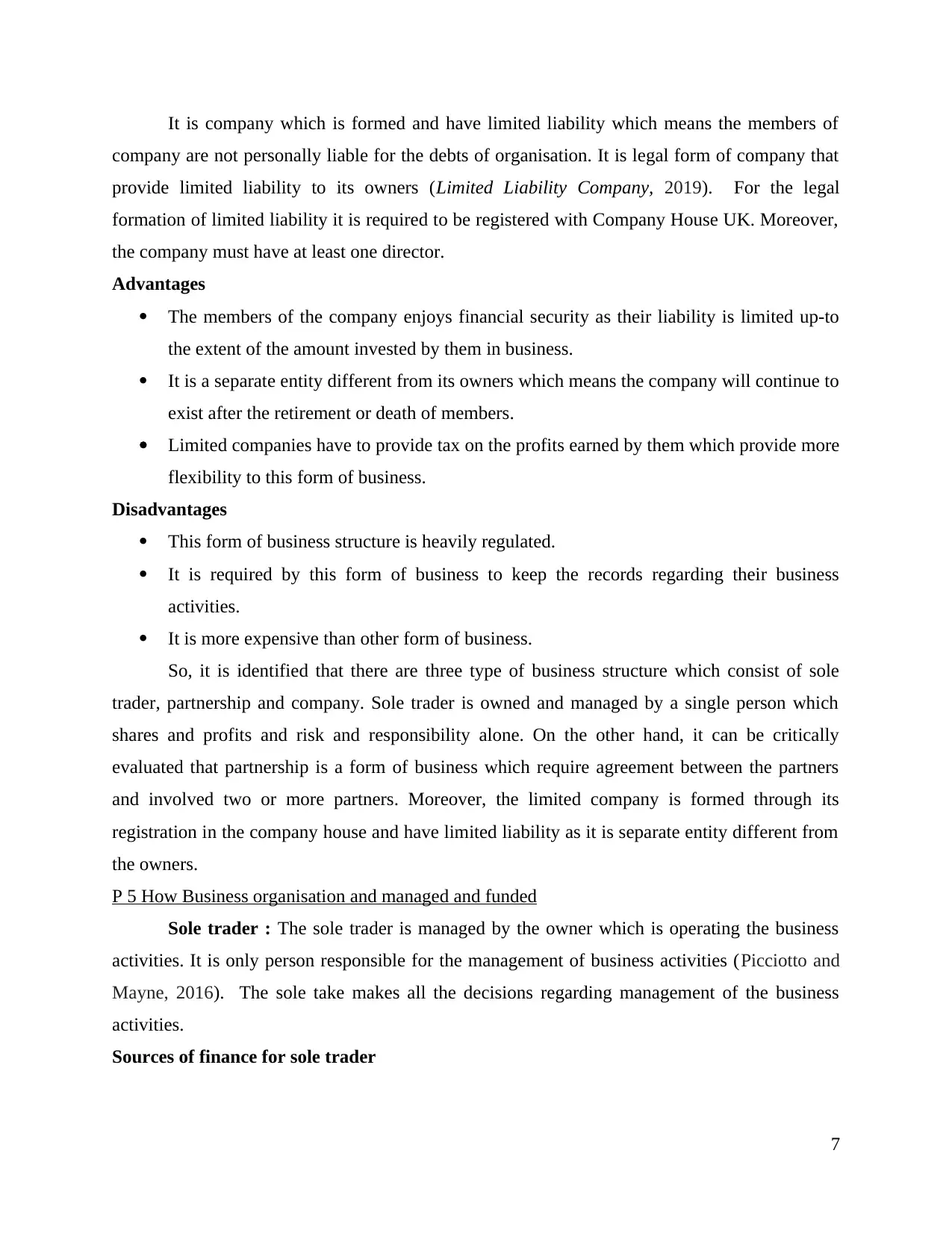
It is company which is formed and have limited liability which means the members of
company are not personally liable for the debts of organisation. It is legal form of company that
provide limited liability to its owners (Limited Liability Company, 2019). For the legal
formation of limited liability it is required to be registered with Company House UK. Moreover,
the company must have at least one director.
Advantages
The members of the company enjoys financial security as their liability is limited up-to
the extent of the amount invested by them in business.
It is a separate entity different from its owners which means the company will continue to
exist after the retirement or death of members.
Limited companies have to provide tax on the profits earned by them which provide more
flexibility to this form of business.
Disadvantages
This form of business structure is heavily regulated.
It is required by this form of business to keep the records regarding their business
activities.
It is more expensive than other form of business.
So, it is identified that there are three type of business structure which consist of sole
trader, partnership and company. Sole trader is owned and managed by a single person which
shares and profits and risk and responsibility alone. On the other hand, it can be critically
evaluated that partnership is a form of business which require agreement between the partners
and involved two or more partners. Moreover, the limited company is formed through its
registration in the company house and have limited liability as it is separate entity different from
the owners.
P 5 How Business organisation and managed and funded
Sole trader : The sole trader is managed by the owner which is operating the business
activities. It is only person responsible for the management of business activities (Picciotto and
Mayne, 2016). The sole take makes all the decisions regarding management of the business
activities.
Sources of finance for sole trader
7
company are not personally liable for the debts of organisation. It is legal form of company that
provide limited liability to its owners (Limited Liability Company, 2019). For the legal
formation of limited liability it is required to be registered with Company House UK. Moreover,
the company must have at least one director.
Advantages
The members of the company enjoys financial security as their liability is limited up-to
the extent of the amount invested by them in business.
It is a separate entity different from its owners which means the company will continue to
exist after the retirement or death of members.
Limited companies have to provide tax on the profits earned by them which provide more
flexibility to this form of business.
Disadvantages
This form of business structure is heavily regulated.
It is required by this form of business to keep the records regarding their business
activities.
It is more expensive than other form of business.
So, it is identified that there are three type of business structure which consist of sole
trader, partnership and company. Sole trader is owned and managed by a single person which
shares and profits and risk and responsibility alone. On the other hand, it can be critically
evaluated that partnership is a form of business which require agreement between the partners
and involved two or more partners. Moreover, the limited company is formed through its
registration in the company house and have limited liability as it is separate entity different from
the owners.
P 5 How Business organisation and managed and funded
Sole trader : The sole trader is managed by the owner which is operating the business
activities. It is only person responsible for the management of business activities (Picciotto and
Mayne, 2016). The sole take makes all the decisions regarding management of the business
activities.
Sources of finance for sole trader
7
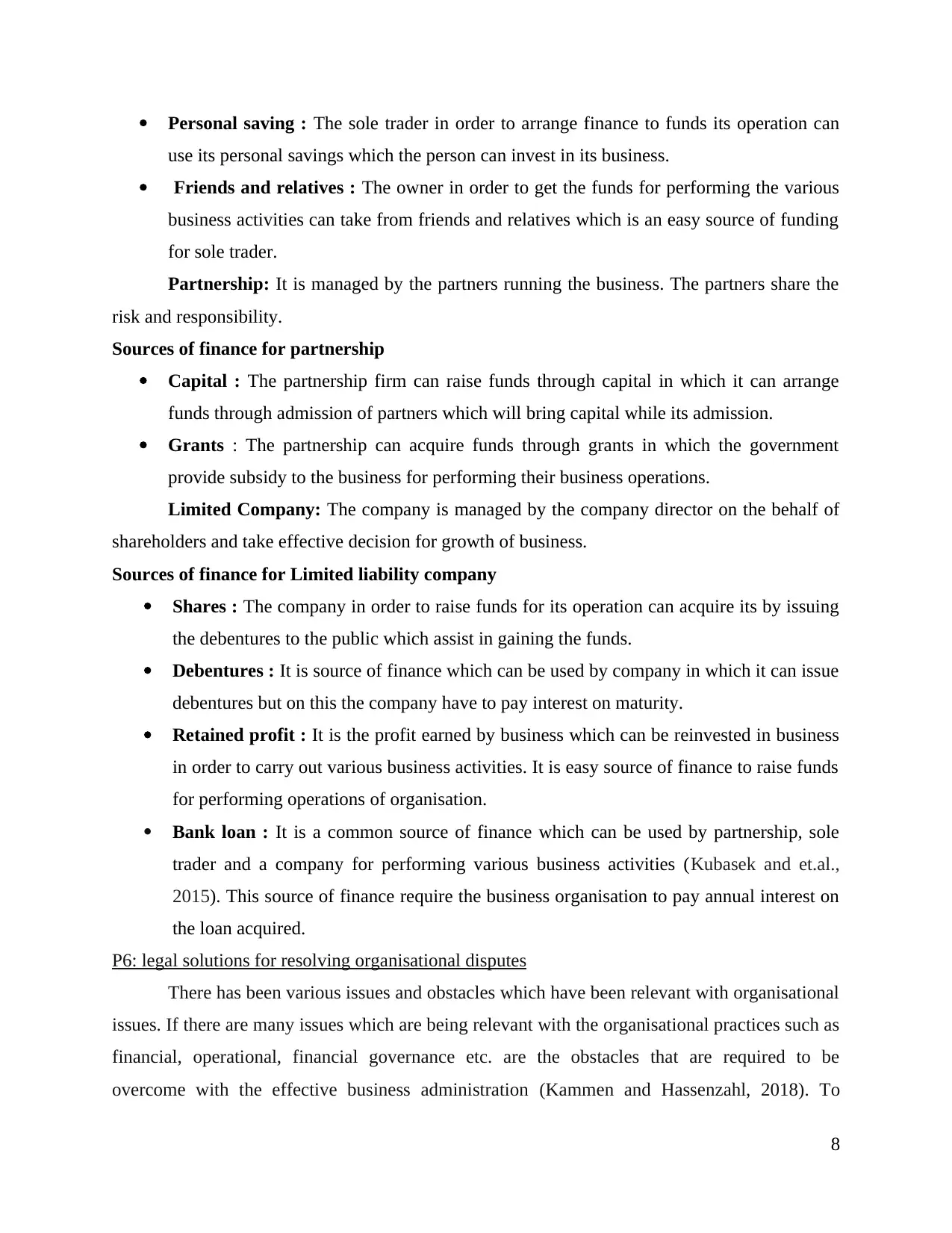
Personal saving : The sole trader in order to arrange finance to funds its operation can
use its personal savings which the person can invest in its business.
Friends and relatives : The owner in order to get the funds for performing the various
business activities can take from friends and relatives which is an easy source of funding
for sole trader.
Partnership: It is managed by the partners running the business. The partners share the
risk and responsibility.
Sources of finance for partnership
Capital : The partnership firm can raise funds through capital in which it can arrange
funds through admission of partners which will bring capital while its admission.
Grants : The partnership can acquire funds through grants in which the government
provide subsidy to the business for performing their business operations.
Limited Company: The company is managed by the company director on the behalf of
shareholders and take effective decision for growth of business.
Sources of finance for Limited liability company
Shares : The company in order to raise funds for its operation can acquire its by issuing
the debentures to the public which assist in gaining the funds.
Debentures : It is source of finance which can be used by company in which it can issue
debentures but on this the company have to pay interest on maturity.
Retained profit : It is the profit earned by business which can be reinvested in business
in order to carry out various business activities. It is easy source of finance to raise funds
for performing operations of organisation.
Bank loan : It is a common source of finance which can be used by partnership, sole
trader and a company for performing various business activities (Kubasek and et.al.,
2015). This source of finance require the business organisation to pay annual interest on
the loan acquired.
P6: legal solutions for resolving organisational disputes
There has been various issues and obstacles which have been relevant with organisational
issues. If there are many issues which are being relevant with the organisational practices such as
financial, operational, financial governance etc. are the obstacles that are required to be
overcome with the effective business administration (Kammen and Hassenzahl, 2018). To
8
use its personal savings which the person can invest in its business.
Friends and relatives : The owner in order to get the funds for performing the various
business activities can take from friends and relatives which is an easy source of funding
for sole trader.
Partnership: It is managed by the partners running the business. The partners share the
risk and responsibility.
Sources of finance for partnership
Capital : The partnership firm can raise funds through capital in which it can arrange
funds through admission of partners which will bring capital while its admission.
Grants : The partnership can acquire funds through grants in which the government
provide subsidy to the business for performing their business operations.
Limited Company: The company is managed by the company director on the behalf of
shareholders and take effective decision for growth of business.
Sources of finance for Limited liability company
Shares : The company in order to raise funds for its operation can acquire its by issuing
the debentures to the public which assist in gaining the funds.
Debentures : It is source of finance which can be used by company in which it can issue
debentures but on this the company have to pay interest on maturity.
Retained profit : It is the profit earned by business which can be reinvested in business
in order to carry out various business activities. It is easy source of finance to raise funds
for performing operations of organisation.
Bank loan : It is a common source of finance which can be used by partnership, sole
trader and a company for performing various business activities (Kubasek and et.al.,
2015). This source of finance require the business organisation to pay annual interest on
the loan acquired.
P6: legal solutions for resolving organisational disputes
There has been various issues and obstacles which have been relevant with organisational
issues. If there are many issues which are being relevant with the organisational practices such as
financial, operational, financial governance etc. are the obstacles that are required to be
overcome with the effective business administration (Kammen and Hassenzahl, 2018). To
8
Secure Best Marks with AI Grader
Need help grading? Try our AI Grader for instant feedback on your assignments.
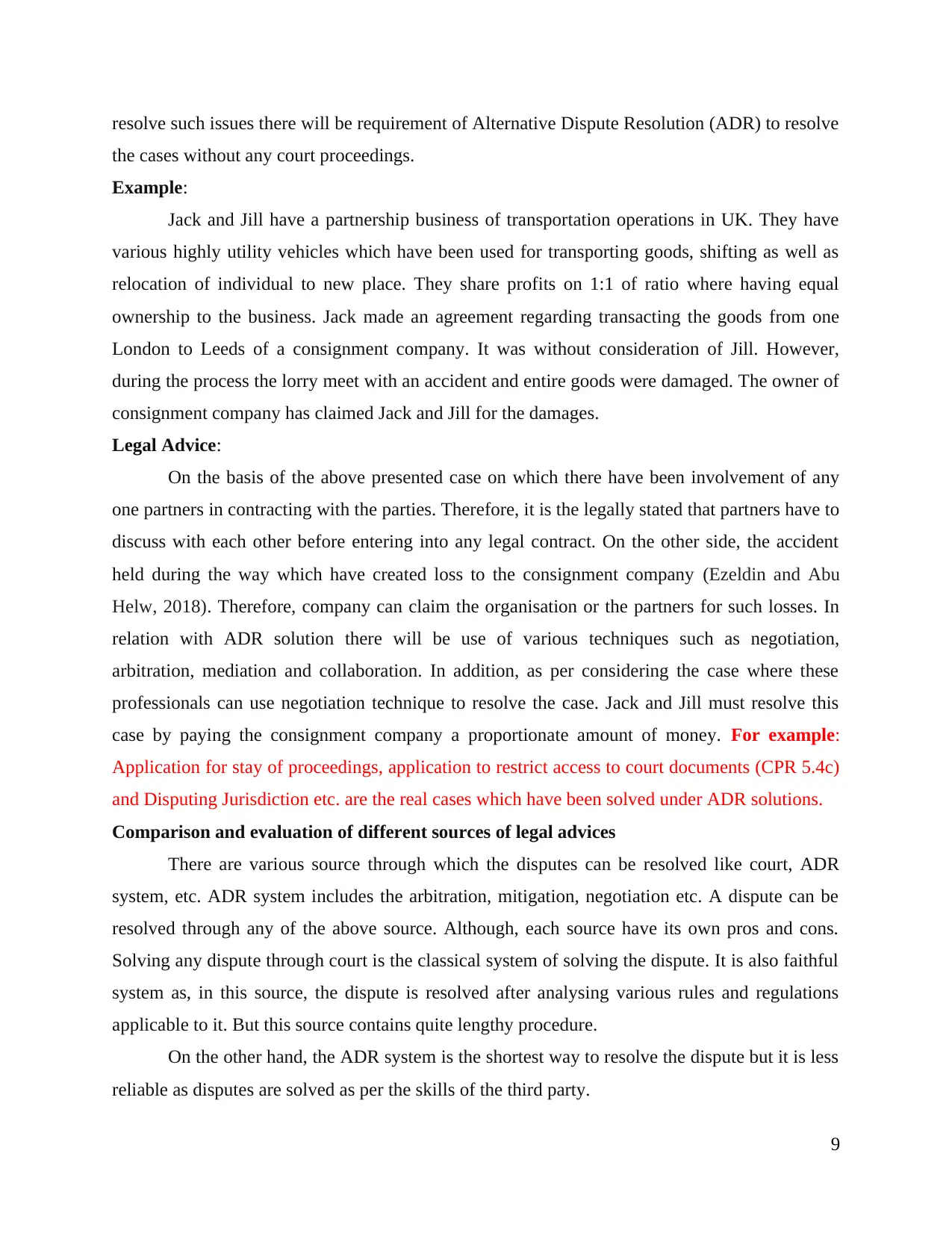
resolve such issues there will be requirement of Alternative Dispute Resolution (ADR) to resolve
the cases without any court proceedings.
Example:
Jack and Jill have a partnership business of transportation operations in UK. They have
various highly utility vehicles which have been used for transporting goods, shifting as well as
relocation of individual to new place. They share profits on 1:1 of ratio where having equal
ownership to the business. Jack made an agreement regarding transacting the goods from one
London to Leeds of a consignment company. It was without consideration of Jill. However,
during the process the lorry meet with an accident and entire goods were damaged. The owner of
consignment company has claimed Jack and Jill for the damages.
Legal Advice:
On the basis of the above presented case on which there have been involvement of any
one partners in contracting with the parties. Therefore, it is the legally stated that partners have to
discuss with each other before entering into any legal contract. On the other side, the accident
held during the way which have created loss to the consignment company (Ezeldin and Abu
Helw, 2018). Therefore, company can claim the organisation or the partners for such losses. In
relation with ADR solution there will be use of various techniques such as negotiation,
arbitration, mediation and collaboration. In addition, as per considering the case where these
professionals can use negotiation technique to resolve the case. Jack and Jill must resolve this
case by paying the consignment company a proportionate amount of money. For example:
Application for stay of proceedings, application to restrict access to court documents (CPR 5.4c)
and Disputing Jurisdiction etc. are the real cases which have been solved under ADR solutions.
Comparison and evaluation of different sources of legal advices
There are various source through which the disputes can be resolved like court, ADR
system, etc. ADR system includes the arbitration, mitigation, negotiation etc. A dispute can be
resolved through any of the above source. Although, each source have its own pros and cons.
Solving any dispute through court is the classical system of solving the dispute. It is also faithful
system as, in this source, the dispute is resolved after analysing various rules and regulations
applicable to it. But this source contains quite lengthy procedure.
On the other hand, the ADR system is the shortest way to resolve the dispute but it is less
reliable as disputes are solved as per the skills of the third party.
9
the cases without any court proceedings.
Example:
Jack and Jill have a partnership business of transportation operations in UK. They have
various highly utility vehicles which have been used for transporting goods, shifting as well as
relocation of individual to new place. They share profits on 1:1 of ratio where having equal
ownership to the business. Jack made an agreement regarding transacting the goods from one
London to Leeds of a consignment company. It was without consideration of Jill. However,
during the process the lorry meet with an accident and entire goods were damaged. The owner of
consignment company has claimed Jack and Jill for the damages.
Legal Advice:
On the basis of the above presented case on which there have been involvement of any
one partners in contracting with the parties. Therefore, it is the legally stated that partners have to
discuss with each other before entering into any legal contract. On the other side, the accident
held during the way which have created loss to the consignment company (Ezeldin and Abu
Helw, 2018). Therefore, company can claim the organisation or the partners for such losses. In
relation with ADR solution there will be use of various techniques such as negotiation,
arbitration, mediation and collaboration. In addition, as per considering the case where these
professionals can use negotiation technique to resolve the case. Jack and Jill must resolve this
case by paying the consignment company a proportionate amount of money. For example:
Application for stay of proceedings, application to restrict access to court documents (CPR 5.4c)
and Disputing Jurisdiction etc. are the real cases which have been solved under ADR solutions.
Comparison and evaluation of different sources of legal advices
There are various source through which the disputes can be resolved like court, ADR
system, etc. ADR system includes the arbitration, mitigation, negotiation etc. A dispute can be
resolved through any of the above source. Although, each source have its own pros and cons.
Solving any dispute through court is the classical system of solving the dispute. It is also faithful
system as, in this source, the dispute is resolved after analysing various rules and regulations
applicable to it. But this source contains quite lengthy procedure.
On the other hand, the ADR system is the shortest way to resolve the dispute but it is less
reliable as disputes are solved as per the skills of the third party.
9
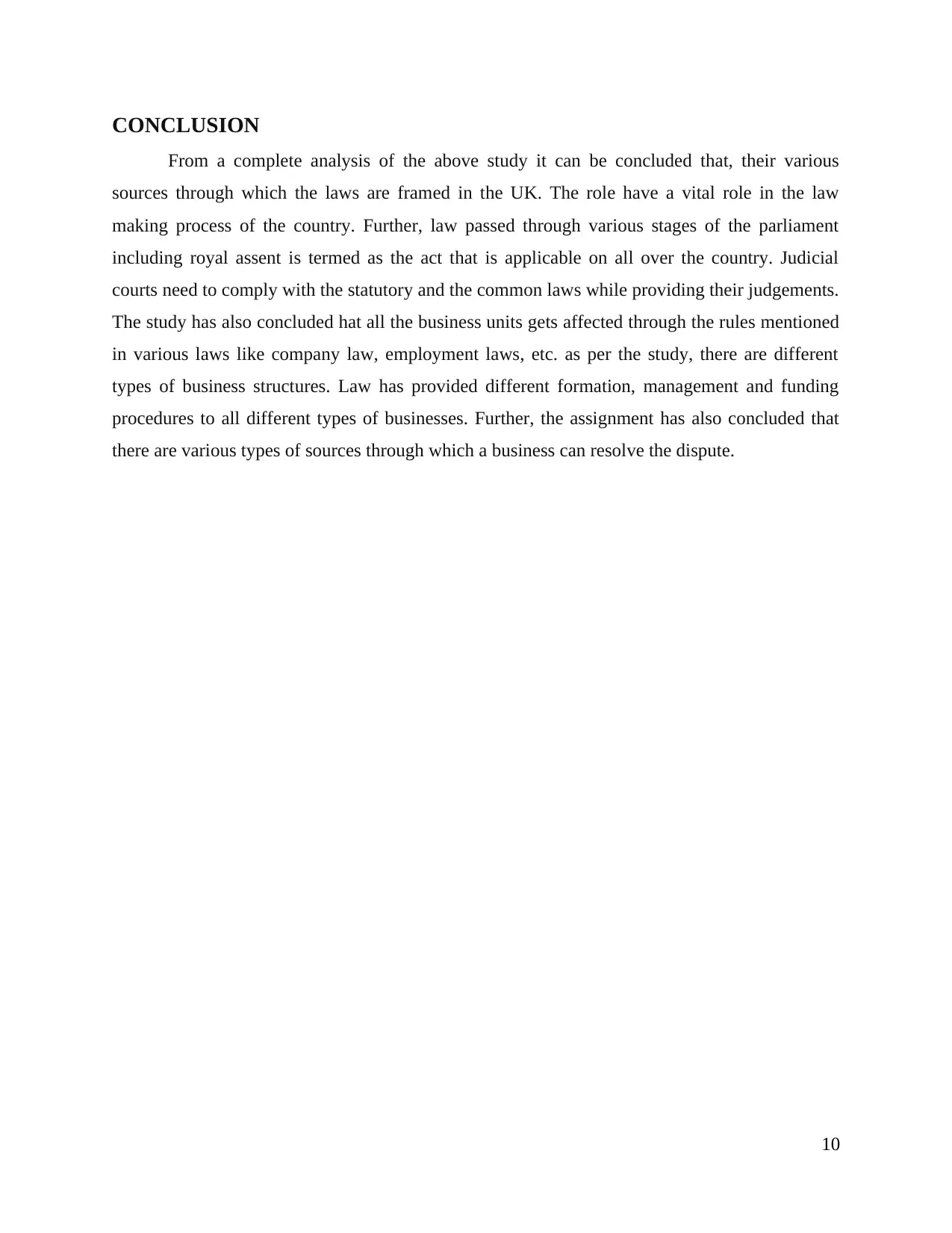
CONCLUSION
From a complete analysis of the above study it can be concluded that, their various
sources through which the laws are framed in the UK. The role have a vital role in the law
making process of the country. Further, law passed through various stages of the parliament
including royal assent is termed as the act that is applicable on all over the country. Judicial
courts need to comply with the statutory and the common laws while providing their judgements.
The study has also concluded hat all the business units gets affected through the rules mentioned
in various laws like company law, employment laws, etc. as per the study, there are different
types of business structures. Law has provided different formation, management and funding
procedures to all different types of businesses. Further, the assignment has also concluded that
there are various types of sources through which a business can resolve the dispute.
10
From a complete analysis of the above study it can be concluded that, their various
sources through which the laws are framed in the UK. The role have a vital role in the law
making process of the country. Further, law passed through various stages of the parliament
including royal assent is termed as the act that is applicable on all over the country. Judicial
courts need to comply with the statutory and the common laws while providing their judgements.
The study has also concluded hat all the business units gets affected through the rules mentioned
in various laws like company law, employment laws, etc. as per the study, there are different
types of business structures. Law has provided different formation, management and funding
procedures to all different types of businesses. Further, the assignment has also concluded that
there are various types of sources through which a business can resolve the dispute.
10
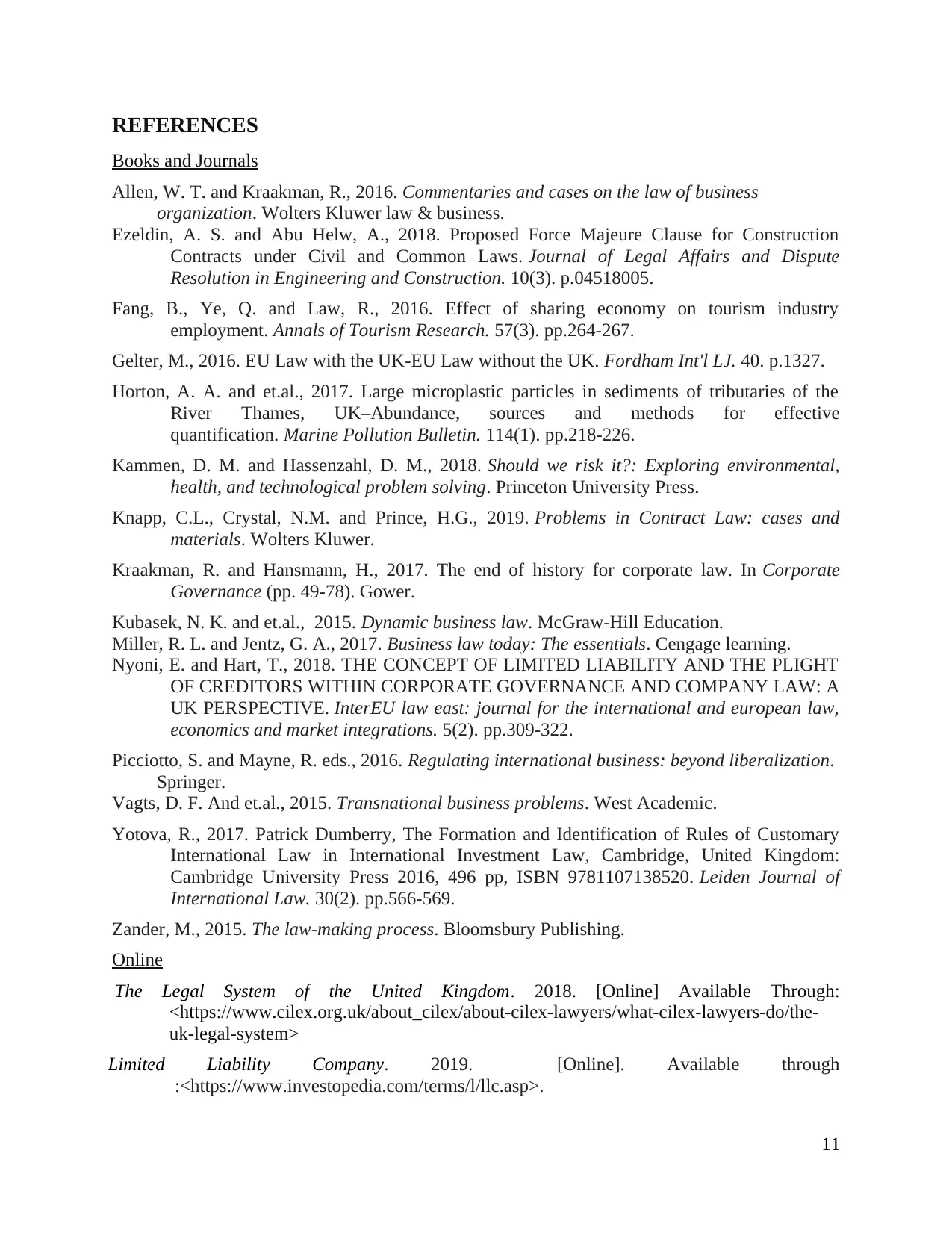
REFERENCES
Books and Journals
Allen, W. T. and Kraakman, R., 2016. Commentaries and cases on the law of business
organization. Wolters Kluwer law & business.
Ezeldin, A. S. and Abu Helw, A., 2018. Proposed Force Majeure Clause for Construction
Contracts under Civil and Common Laws. Journal of Legal Affairs and Dispute
Resolution in Engineering and Construction. 10(3). p.04518005.
Fang, B., Ye, Q. and Law, R., 2016. Effect of sharing economy on tourism industry
employment. Annals of Tourism Research. 57(3). pp.264-267.
Gelter, M., 2016. EU Law with the UK-EU Law without the UK. Fordham Int'l LJ. 40. p.1327.
Horton, A. A. and et.al., 2017. Large microplastic particles in sediments of tributaries of the
River Thames, UK–Abundance, sources and methods for effective
quantification. Marine Pollution Bulletin. 114(1). pp.218-226.
Kammen, D. M. and Hassenzahl, D. M., 2018. Should we risk it?: Exploring environmental,
health, and technological problem solving. Princeton University Press.
Knapp, C.L., Crystal, N.M. and Prince, H.G., 2019. Problems in Contract Law: cases and
materials. Wolters Kluwer.
Kraakman, R. and Hansmann, H., 2017. The end of history for corporate law. In Corporate
Governance (pp. 49-78). Gower.
Kubasek, N. K. and et.al., 2015. Dynamic business law. McGraw-Hill Education.
Miller, R. L. and Jentz, G. A., 2017. Business law today: The essentials. Cengage learning.
Nyoni, E. and Hart, T., 2018. THE CONCEPT OF LIMITED LIABILITY AND THE PLIGHT
OF CREDITORS WITHIN CORPORATE GOVERNANCE AND COMPANY LAW: A
UK PERSPECTIVE. InterEU law east: journal for the international and european law,
economics and market integrations. 5(2). pp.309-322.
Picciotto, S. and Mayne, R. eds., 2016. Regulating international business: beyond liberalization.
Springer.
Vagts, D. F. And et.al., 2015. Transnational business problems. West Academic.
Yotova, R., 2017. Patrick Dumberry, The Formation and Identification of Rules of Customary
International Law in International Investment Law, Cambridge, United Kingdom:
Cambridge University Press 2016, 496 pp, ISBN 9781107138520. Leiden Journal of
International Law. 30(2). pp.566-569.
Zander, M., 2015. The law-making process. Bloomsbury Publishing.
Online
The Legal System of the United Kingdom. 2018. [Online] Available Through:
<https://www.cilex.org.uk/about_cilex/about-cilex-lawyers/what-cilex-lawyers-do/the-
uk-legal-system>
Limited Liability Company. 2019. [Online]. Available through
:<https://www.investopedia.com/terms/l/llc.asp>.
11
Books and Journals
Allen, W. T. and Kraakman, R., 2016. Commentaries and cases on the law of business
organization. Wolters Kluwer law & business.
Ezeldin, A. S. and Abu Helw, A., 2018. Proposed Force Majeure Clause for Construction
Contracts under Civil and Common Laws. Journal of Legal Affairs and Dispute
Resolution in Engineering and Construction. 10(3). p.04518005.
Fang, B., Ye, Q. and Law, R., 2016. Effect of sharing economy on tourism industry
employment. Annals of Tourism Research. 57(3). pp.264-267.
Gelter, M., 2016. EU Law with the UK-EU Law without the UK. Fordham Int'l LJ. 40. p.1327.
Horton, A. A. and et.al., 2017. Large microplastic particles in sediments of tributaries of the
River Thames, UK–Abundance, sources and methods for effective
quantification. Marine Pollution Bulletin. 114(1). pp.218-226.
Kammen, D. M. and Hassenzahl, D. M., 2018. Should we risk it?: Exploring environmental,
health, and technological problem solving. Princeton University Press.
Knapp, C.L., Crystal, N.M. and Prince, H.G., 2019. Problems in Contract Law: cases and
materials. Wolters Kluwer.
Kraakman, R. and Hansmann, H., 2017. The end of history for corporate law. In Corporate
Governance (pp. 49-78). Gower.
Kubasek, N. K. and et.al., 2015. Dynamic business law. McGraw-Hill Education.
Miller, R. L. and Jentz, G. A., 2017. Business law today: The essentials. Cengage learning.
Nyoni, E. and Hart, T., 2018. THE CONCEPT OF LIMITED LIABILITY AND THE PLIGHT
OF CREDITORS WITHIN CORPORATE GOVERNANCE AND COMPANY LAW: A
UK PERSPECTIVE. InterEU law east: journal for the international and european law,
economics and market integrations. 5(2). pp.309-322.
Picciotto, S. and Mayne, R. eds., 2016. Regulating international business: beyond liberalization.
Springer.
Vagts, D. F. And et.al., 2015. Transnational business problems. West Academic.
Yotova, R., 2017. Patrick Dumberry, The Formation and Identification of Rules of Customary
International Law in International Investment Law, Cambridge, United Kingdom:
Cambridge University Press 2016, 496 pp, ISBN 9781107138520. Leiden Journal of
International Law. 30(2). pp.566-569.
Zander, M., 2015. The law-making process. Bloomsbury Publishing.
Online
The Legal System of the United Kingdom. 2018. [Online] Available Through:
<https://www.cilex.org.uk/about_cilex/about-cilex-lawyers/what-cilex-lawyers-do/the-
uk-legal-system>
Limited Liability Company. 2019. [Online]. Available through
:<https://www.investopedia.com/terms/l/llc.asp>.
11
Paraphrase This Document
Need a fresh take? Get an instant paraphrase of this document with our AI Paraphraser

12
1 out of 14
Related Documents
Your All-in-One AI-Powered Toolkit for Academic Success.
+13062052269
info@desklib.com
Available 24*7 on WhatsApp / Email
![[object Object]](/_next/static/media/star-bottom.7253800d.svg)
Unlock your academic potential
© 2024 | Zucol Services PVT LTD | All rights reserved.





